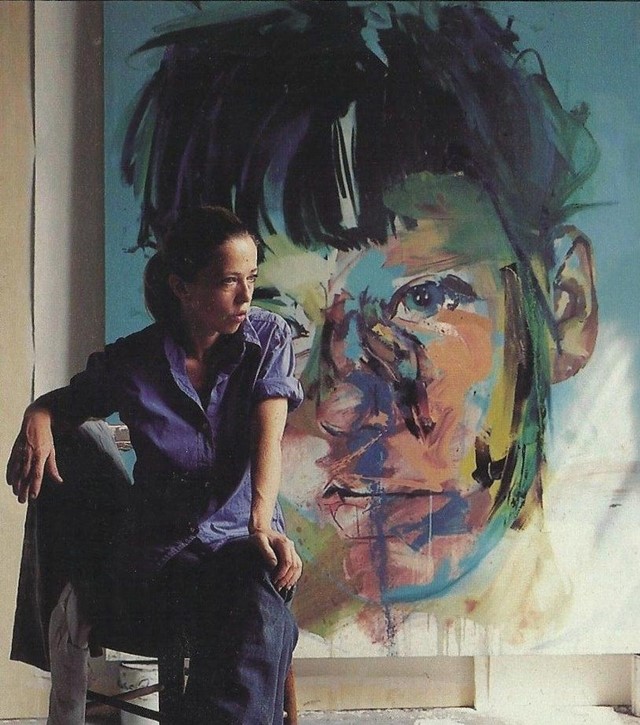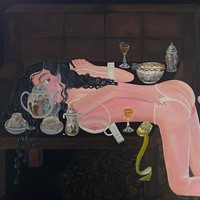Learn first hand from one of the art world’s biggest disruptors
Figurative artist Jenny Saville is so entwined with her craft that even when she speaks, her words form visceral images which reveal the raw, grotesque, and powerfully human moments of life. Since her rise as a YBA artist alongside Sarah Lucas and Tracey Emin, she has unrepentantly disrupted the art world and bought new life to stagnant ideals on the human body. After her painting “Propped” (1992) sold for $9.5 million at auction, Saville stands as the most expensive living female artist in the world.
As an extension of the All Too Human exhibition at Tate Britain earlier this year, she participated in an artists talk at the museum where she spoke honestly about her career and the many intricate references (from as far and wide as Cy Twombly, to Chaim Soutine, and graffiti) that inform the layers of her intense works (some of which have been labelled the most extreme artworks ever made).
Below we share some of the lessons we learned from the talk, including unknown facts about the leading figure.
PAINT FROM LIFE’S FORCE
Jenny Saville: When I paint, I don’t search for beauty, but for the power of life’s force: when you fall in love with someone, it's life’s force. When you see amazing food or you listen to music that goes right inside your body, that’s life’s force. That moment is not an intellectual space, it's something beyond – you can't articulate it. It’s about the moments that help you breathe deeper.
LOOK TO ANCIENT ART TO BLUR GENDER
Jenny Saville: Early on I was angry, but you can't stay pissed off all the time – it's not a very pleasant way to live. It wasn't anger, I had a very big sense of purpose trying to depict what being a female was like, in terms of the traditional figure being looked at. As a painter, your job is to look, and as a female, your traditional role is to be looked at. So the marriage of those two things together (are) almost in conflict. If you want to be an artist as a female, it's almost as if you're trespassing on another tradition. That's how I felt at that time. Now I don't believe that's the case because I've been able to look at older art, very ancient art, after which the idea of the prehistoric female as creator has become more prominent in my work. (We don’t know who made) a lot of the very early fertility sculptures, like the Venus of Holy Fels. I found looking at very ancient art where the author isn't there (to be) very liberating. You don't know if it's male or female, what the reason is for it, and so it becomes a free area of art.
There are certain ways that I build figures of couples that are two women, or a man and a woman, by layering bodies up. I moved from making a piece of a hermaphrodite or a transgender body, a singular body, to making work that is gender ambiguous... through layering. (It’s) really exciting, it's a whole new way of creating a body which isn't male or female which feels very contemporary.
CONFRONT ART WORLD PREJUDICE AS A FEMALE ARTIST BY USING FEMINISM
Jenny Saville: When I look back to my very early work I was informed by studying in America, where there were a lot of women's studies programmes. I went to a lot of theoretical courses that weren’t part of painting school where I learned about patriarchal systems and it gave me a platform to explain the way that I felt. Suddenly I had a sense of purpose. I was a painter trying to navigate painting, and then I had myself as a female doing those things. The next body of work was about articulating how systems work. If there’s something feminism taught me early on, it’s that if you meet prejudice, not in the actual nuts and bolts of making art, but in terms of career, feminism allows you to use that knowledge of patriarchal systems to understand why it’s happening to you, to carry on, and not lose confidence by it. Learning this was a great gift.
“As a painter, your job is to look, and as a female, your traditional role is to be looked at. So the marriage of those two things together (are) almost in conflict” – Jenny Saville
FIND YOUR MEDIUM AND INNOVATE IT
Jenny Saville: I thought about being an abstract painter because I love abstract painting, but I can’t let go of the figure. I went to Paris to see the current Picasso show, which is absolutely amazing, and I walked around and thought, ‘thank god I didn't become an abstract painter’. Because as a figurative artist, you've got the whole of history with you. And it's so difficult to make something interesting as a figurative artist, but I really love paint and abstract painting, so I try to navigate that.
SHAKE UP LIFE MODELLING PROCESSES TO BRING YOUR MODELS TO LIFE
Jenny Saville: Life models don't sit like human beings sit. They sit in academic poses that are life-like, so it's almost a special genre of humanism in the life room, and that was of no interest to me at all. I learned a lot in the life room in terms of the nuts and bolts of painting, but in terms of humanity... that was on the street outside. Or that was my friend who was drawing on her leg because she was on a diet and wanted her body to be thinner – that was what I was interested in. I found a huge separation between the life room and real life, but I was interested in the life room because I was a figurative painter. If anyone sat still for long enough when I was a child, I just ended up drawing them or painting them. Or I had friends who would read books for a long time lying on my bed and I'd be painting them just because that was the language that grew around me.
If I had a live model, I think I'd be too slavish to the model photographing models or drawing models gives me an arch I can work with, so I don't have boundaries. If I'm not painting from life directly then it's not good enough or it's not real. If I have models come into my studio and I take 2000 photographs of them sitting in different positions and I photograph them constantly until I feel like I've grappled with something which is closer to life than if I'd asked that model to stay still. I find this way of working more like working from life because I believe it’s an unreal experience when you ask someone to sit in a certain way.
DON’T BE AFRAID OF UNCONVENTIONAL TOOLS
Jenny Saville: I love pastels so much because they're so untrendy. I love Degas’ use of pastels, and also the colour is just so incredible; they're so dense. I have ranges and ranges of them, and it's made me more daring with paint because I'll use a lime green with a purple, where usually if I was making up those colours I probably wouldn't think like that. The difference is when you're making a painting you can mix a specific colour exactly, but with pastels mixing them doesn't make the exact colour which has been fantastic for me because it's opened the possibility of saying well you don't have the colour so what could you do instead? I think that's what Degas was able to achieve dramatically, if you look at his patterns up close they have this incredible layering, and you layer because you're trying to create the actual tone. Once you've got all sophisticated with it, you become more daring. You know those red maple trees? The shock of that red against the blue sky, that life force, when your head rolls back and you shudder like, ‘wow, how did nature make colour so amazing’ – pastels can be like that! So I work with trying to get that level of life force into my paintings.
LOOK BEYOND TRADITIONAL ART
Jenny Saville: I photograph graffiti all the time, Anyone who travels with me will know – ask my children, they go, ‘oh no she's at it again’ (laughs). Graffiti is so beautiful because the colours can be quite arbitrary as they aren’t composed colours. One of the reasons why Picasso was so groundbreaking is that he was putting together colours that nobody had thought of putting together which were quite shitty, but they really work. With graffiti, because it's a communal thing, you have somebody spray colours on in purple and blue and somebody else comes along and puts a red or a pink on the top, and it's a visual shock. Those colours, they're something that a lot of artists wouldn't put together, so I found them inspiring, and also when you photograph a language that you don't understand the whole thing is just pictorial. Tags, I just love tags. I like the bleed of spray paint, where it’s intense colour and then it's sort of soft colour at the edge – there's something very sensual about that, and it's incredibly flat.




